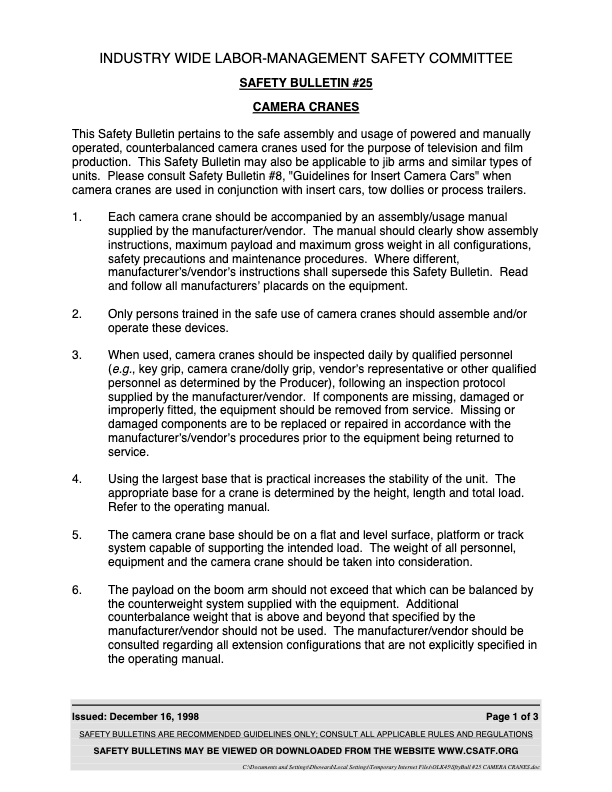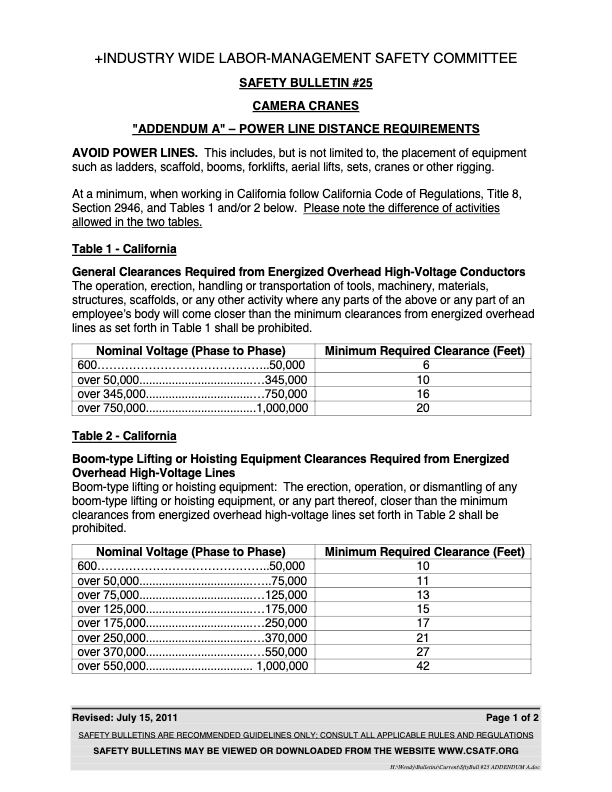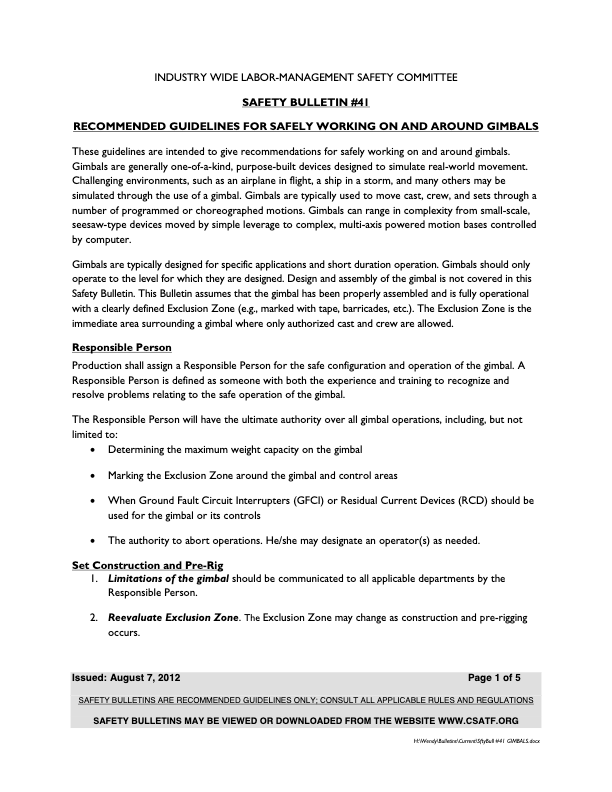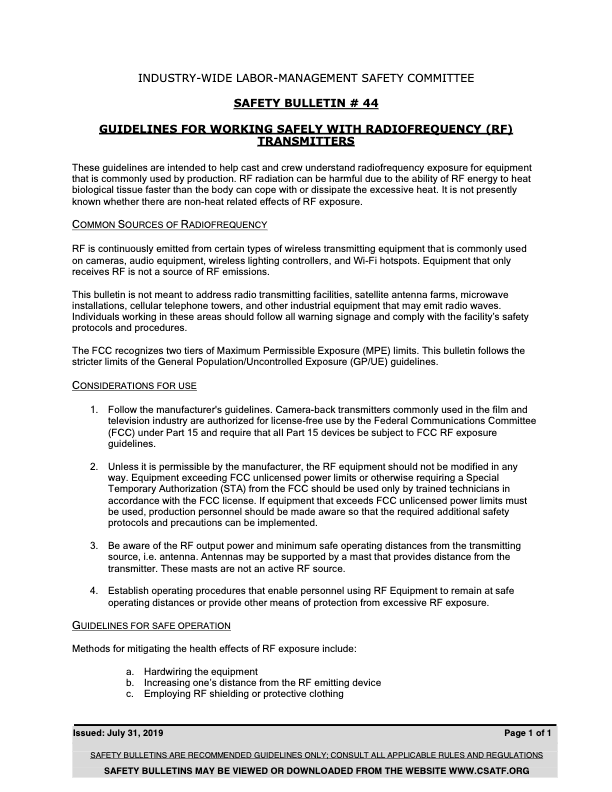Safety Bulletin

Guidelines
The following guidelines are for the indoor and outdoor use of UAS.
Outdoor use of UAS must follow Federal, state, and local regulatory limitations or restrictions (including Federal Aviation Administration (FAA) Section 333 or Part 107 regulations), as well as Authority Having Jurisdiction (AHJ) regulations, as applicable. If there are any conflicts between these guidelines and Federal Regulations, the Federal Regulations will apply.
UAS, a.k.a. “drones”, combine the use of aeronautics, electronics, and wireless transmission technologies through the use of a remote-controlled or a programmable unit. UAS types include, but are not limited to, helicopters, multi-rotor, fixed wing aircraft, small UAS (sUAS), and micro UAS.
These guidelines cover motion picture and television operations including, but not limited to, camera platforms, image and data capture, lighting, special effects, and when the UAS is flown as a prop.
Guidelines for Operation
- The UAS Operator or Pilot in Command (PIC) must provide their authorization and/or waiver from the proper regulatory authority and/or AHJ to the production prior to any flight operations.
- The PIC is at all times the final authority over the UAS, shall be in command over all flight operations and/or related activities, and be certified and trained, as appropriate. The PIC shall have the final authority to abort any flight operation in the interest of safety. Abort signals shall be specified ahead of time.
- The PIC, or a person knowledgeable of the flight operation that has been designated by the UAS Operator, will establish the communication protocols with the designated production representative to implement a plan for communications.
- Once the UAS is airborne, no change will be made to any sequence without authorization from the PIC.
- Equipment shall not be attached to, nor altered on, the UAS without the authorization of the PIC.
- Unless authorized by the PIC or a person knowledgeable of the flight operation that has been designated by the UAS Operator, no personnel shall approach the UAS, whether it is running or not.
- An exclusion zone must be established for the setup, testing, takeoff, and landing of the UAS. This zone should be cleared of all debris, including trash or anything else that may hinder the operation of the UAS. All equipment (e.g., cameras, lights, sound booms, etc.) shall be placed at a safe distance away from the zone.
- Access to areas where UAS are in operation shall be limited to authorized personnel only. All other personnel shall remain at a designated safe distance. If needed to prevent unintentional entry into potentially hazardous areas, warning signs should be posted and/or other appropriate precautions taken.
- Never throw anything such as grip tape, clothing, paper, etc., around the UAS.
- Personal Protective Equipment (PPE) (such as earplugs) shall be provided and worn, as appropriate.
- The PIC, or a person knowledgeable of the flight operation that has been designated by the UAS Operator, is responsible for determining if there are any potential radio frequencies or electrical transmissions (devices such as Wi-Fi routers and mobile phone boosters or repeaters) that could interfere with or affect the safe operation of the UAS. Cast and crew members with electrical or transmission equipment should contact the PIC to see if it may affect the operation of the UAS.
- The storage and transportation of batteries shall be in compliance with all applicable federal, state, and local laws and regulations and any shipping company restrictions. For transportation of batteries by air, refer to airline policy and International Air Transport Association (IATA) regulations.
- Appropriate precautions (i.e. fire extinguishers, no smoking, etc.) should be taken for flammable fuel sources.
- All UAS shall have a FAA registration number, as applicable.
- The flying accuracy of the UAS may be adversely affected by natural conditions such as wind, air density, temperature, gross weight, humidity, and time of day. Man-made conditions such as a weight load, wind (fans), explosives disturbing airflow and center of gravity can also affect the flight control of the UAS.
- There may be times when the UAS is used as a toy or as a prop. Safety precautions for these types of uses should be developed in conjunction with the corresponding risk they present, and when used outside is subject to FAA regulations.
- Prior to each flight, the UAS should be inspected by the PIC, or a person knowledgeable of the flight operation that has been designated by the UAS Operator, to determine that the UAS is safe for flight.
- Prior to each flight, the boundaries and intended flight path shall be checked to ensure they are cleared for UAS operations.
- Authorities Having Jurisdiction (AHJ) may have their own requirements regarding UAS operations.
- At the start of each day’s filming, the PIC or a person knowledgeable of this flight operation that has been designated by the UAS Operator, and the designated production representative will conduct a briefing/safety meeting for the cast and crew and those persons necessary for filming. Briefings/Safety Meetings should include a discussion of the following:
- Possible risk to personnel involved
- Safeguards to personnel, animals, and equipment
- Communications, including chain of command; and emergency procedures, including landing zone(s) and designated safety zone(s)
- Boundaries and intended flight paths
- The intended use of any stunts or special effects during UAS operations
- Electronic devices and/or other equipment that may interfere with UAS operations
- Obstacles, equipment and/or locations that may present a hazard
- Abort signals, audible and/or visual, used to halt filming in the event of unforeseen circumstances or safety hazards
- Federal, state, and local regulatory limitations or restrictions, if applicable
- Any exemptions or waivers that are unique to the UAS operator, including flying over people, operating from a moving vehicle, flying at night, etc. and additional safety precautions that need to be taken, if any
Operation Over People
Federal regulations prohibit flying over people during UAS operations, unless the UAS Operator is specifically approved to do so or has been granted a waiver by the FAA, OR they are “participating personnel”.
For the purposes of outdoor filming, Federal regulations define flying “over” people as the UAS flight path being directly over any part of a person. For example, a UAS that hovers directly over a person’s head, shoulders, extended arms or legs would be an operation over people.
Participating Personnel
For the purposes of outdoor filming, Federal regulations define “participating personnel” as ONLY those that are directly participating in the safe operation of the UAS, such as the PIC and/or Visual Observer. (Flying over all other personnel, including cast and crew, requires FAA approval or waiver.)
If required for “non-participants”, safe barriers may include a covered structure or a covered stationary vehicle.
Notification
The Production Company must notify all production personnel of the planned use of UAS so that any objection can be communicated prior to UAS operation. Notification can be accomplished by including a statement like the following on the call sheet:
“An Unmanned Aircraft System (UAS) will be used in close proximity to production personnel and equipment. Any personnel who does not consent to working within the UAS area must notify (insert the assigned production designee(s)) prior to use of the UAS.”
Indoor Use
- As a general matter of safe work practices, the “Guidelines for Operation” and “Notification” procedures listed above should be followed during indoor UAS operations. Note: The indoor use of UAS is not regulated by Federal regulations; however, AHJ regulations may apply.
- Indoor conditions such as increased heat resulting in reduced air density and ventilation systems could adversely affect flying characteristics.
- The PIC or a person knowledgeable of this flight operation that has been designated by the UAS Operator, and the designated production representative should evaluate the indoor location for items such as interior sets, walls, ceiling beams, lighting equipment, rigging, cables, HVAC equipment, etc. and consider these potential hazards before operation of the UAS. The proximity of the UAS to cast and crew and a live audience, if applicable, and any planned special effects or stunts should also be considered.






